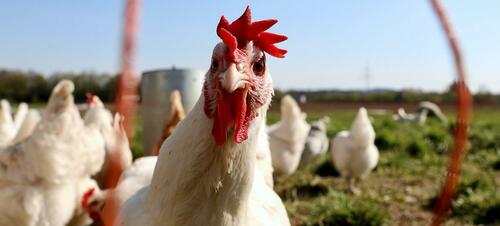
Since the Highly Pathogenic Avian Influenza (HPAI) H5N1 virus was first identified in humans in 2003, approximately 600 cases have been reported worldwide, with a laboratory-confirmed case-fatality rate (CFR) of 60%.
The recent death of a woman in southwest China who had no contact with poultry signals a potentially alarming shift in the virus's transmission dynamics, raising the specter of human-to-human transmission, according to a report by the Federation of American Scientists.
Health authorities in Guiyang, Guizhou province concluded that two patients, including the woman who died, did not have contact with poultry before showing symptoms of the illness. Currently, the public health community remains cautious as H5N1 influenza viruses continue to evolve and potentially gain the ability to be transmitted efficiently to humans.
The evolution of H5N1 over two decades necessitates an urgent and strategic response from the global health community. Scientific efforts are primarily focused on understanding the genetic shifts that facilitate the virus’s leap among species, aiming to forestall a possible pandemic. This has led to the controversial practice of gain-of-function (GoF) research, wherein viruses are deliberately engineered to be more potent or transmissible.
And of course, as we all know - a bunch of over-educated idiots cobbling together chimeric viruses that can better-infect humans may have led to the COVID-19 pandemic - as GoF research is fraught with ethical, biosafety, and biosecurity dilemmas.
The dual-use nature of this research—where scientific advances could potentially be misused to cause harm—places it under intense scrutiny. The debate is not just about managing the risks of accidental release but also about the moral implications of potentially providing a blueprint for bioterrorism. This precarious balance between advancing human knowledge and safeguarding public health was thrown into relief in 2012 when a moratorium was placed on H5N1 GoF studies following experiments that showed increased transmissibility in ferrets, an established model for human influenza transmission.
Biosafety risks include laboratory-acquired infections or accidental release of the virus, which are major threats for public health. In fact, last year, researchers around the world took the remarkable step of imposing a moratorium on “gain-of-function” experiments due to concerns about public health risks. The following provides answers to basic questions about the risks of this type of research, the status of the moratorium, and what steps are being taken to mitigate future public health risks. -FAS
This isn't the first time scientists have policed themselves over security concerns. In 1974, scientists self-imposed a moratorium on recombinant DNA (rDNA) technology due to emerging bioethical concerns, resonates with today’s GoF debates. Like their predecessors, modern scientists are deeply entwined in discussions about the bounds and oversight of high-stakes research. In 1975, scientists at the Asilomar Conference on Recombinant DNA set out with a goal of considering whether to lift the voluntary moratorium - and if so, under what circumstances could the research proceed safely.
The moratorium was enacted by scientists and governments to protect laboratory personnel, the general public, and the environment from potential hazards that might be directly generated from rDNA experiments. During the conference, recommendations were established for how to safely conduct experiments using rDNA. The debate on potential biohazards was the primary focus of the conference, which is still a continued discussion in biotechnology today.
More via the Federation of American Scientists;
How many researchers/countries are involved in “gain-of-function” experiments?
The letter that announced the voluntary moratorium on H5N1 transmission research, published in Science and Nature, was signed by 40 leading influenza researchers from the United States, China, Japan, Britain, the Netherlands, Hong Kong, Germany, Italy, and Canada. Everyone, in some way, may be affected by “gain-of-function” experiments. The “gain-of-function” experiments have a plethora of stakeholders within the international community. In December 2012, the United States hosted the “Gain-of-Function Research on Highly Pathogenic Avian Influenza H5N1 Viruses: An International Consultative Workshop.” This workshop integrated experts in various fields, including: influenza and other infectious diseases, bioethics, public health surveillance, biosafety, national and global public health, biosecurity, epidemiology, national security, agriculture and veterinary sciences, global public health law and those specifically involved with developing the WHO International Health Regulations and the Pandemic Influenza Preparedness Framework, and medical countermeasures to disease outbreak. While the purpose of the moratorium was primarily to take time to discuss risk/benefit analysis of gain-of-function experiments, another important consideration was how to educate the public and gain their acceptance for continued research.
What new steps are being taken to minimize the risk of H5N1 research to public health?
The RAC of the National Institutes of Health (NIH) has called for additional precautions on H5N1 “gain-of-function” experiments that are conducted strictly in biosafety level 3 (BSL-3) laboratories, which have been used in recent studies on H5N1 transmissibility. The committee has rejected the option of restricting research to facilities designated as BSL-4 – the highest level of biosafety laboratories – because only a few laboratories around the world would meet this standard. Limiting H5N1 research to only these labs would slow the pace of discovery. Additionally, many experts argue H5N1 experiments can safely be done in BSL-3 with enhanced safeguards. Existing BSL-3 laboratory requirements include: powered air purifying respirators (PAPRS), donning a protective suit, wrap-back disposable gowns, double gloving, shoe covers, and a shower before exiting the laboratory. The recommended steps are aimed at reducing the risk of laboratory-acquired infections and the accidental release of the dangerous pathogens. The additional requirements devised recently by the RAC include: increased personal protective equipment (PPE), a “buddy system” for all personnel, maintaining baseline serum samples, providing a licensed H5N1 vaccine, and requiring personnel to avoid contact with susceptible bird species for five days after working with the viruses. The RAC also recommended proper training of lab personnel would be essential and recommended that personnel be required to sign a statement confirming that they understand the safety and incident-reporting requirements. Additionally, the RAC recommended that all incidents that have the potential to be harmful to personnel and/or the public be reported to institutional authorities immediately and to public health officials within 24 hours.
What are the recommended next steps for the United States concerning the recent moratorium?
Although the H5N1 international research moratorium was lifted in January 2013, the United States has yet to resume research involving gain-of-function experiments on the H5N1 virus and is currently designing a framework for the Department of Health and Human Services (HHS) to make judgments about funding for this type of research. This framework will provide HHS’ funding agencies with guidance on how to classify potentially high-risk gain-of-function projects at the funding proposal stage and make determinations as to whether they are acceptable for HHS funding. For the proposals that are deemed acceptable for funding, the framework will also establish a basis for HHS’ funding agencies to designate any additional biosafety, biosecurity, and DURC risk mitigation measures that they will require of researchers.
With China’s February report of two new human cases of H5N1, the debate of moving forward with “gain-of-function” research remains of upmost importance for global public health. In light of the new cases, researchers are insistent to resume experimentation on the deadly virus in hopes to produce results for prevention or new countermeasures. But the dangerousness of the virus underscores the importance of prioritizing safety when carrying out this research, even if it means pausing for a moment to make sure experimentation does not inadvertently create more problems than it solves.
Malerie Briseno is a Biosecurity Intern at the Federation of American Scientists. She graduated from Georgetown University’s School of Medicine with a M.S. in Biohazardous Threat Agents and Emerging Infectious Diseases.
Christina England is currently a Masters Candidate from the University of Maryland School of Public Policy, specializing in International Security and Economic Policy. She is serving as a biosecurity intern at the Federation of American Scientists, overseeing its Virtual Biosecurity Center. She graduated from the United States Air Forces Academy as distinguished graduate, receiving her BS in Biochemistry.
Since the Highly Pathogenic Avian Influenza (HPAI) H5N1 virus was first identified in humans in 2003, approximately 600 cases have been reported worldwide, with a laboratory-confirmed case-fatality rate (CFR) of 60%.
The recent death of a woman in southwest China who had no contact with poultry signals a potentially alarming shift in the virus’s transmission dynamics, raising the specter of human-to-human transmission, according to a report by the Federation of American Scientists.
Health authorities in Guiyang, Guizhou province concluded that two patients, including the woman who died, did not have contact with poultry before showing symptoms of the illness. Currently, the public health community remains cautious as H5N1 influenza viruses continue to evolve and potentially gain the ability to be transmitted efficiently to humans.
The evolution of H5N1 over two decades necessitates an urgent and strategic response from the global health community. Scientific efforts are primarily focused on understanding the genetic shifts that facilitate the virus’s leap among species, aiming to forestall a possible pandemic. This has led to the controversial practice of gain-of-function (GoF) research, wherein viruses are deliberately engineered to be more potent or transmissible.
And of course, as we all know – a bunch of over-educated idiots cobbling together chimeric viruses that can better-infect humans may have led to the COVID-19 pandemic – as GoF research is fraught with ethical, biosafety, and biosecurity dilemmas.
The dual-use nature of this research—where scientific advances could potentially be misused to cause harm—places it under intense scrutiny. The debate is not just about managing the risks of accidental release but also about the moral implications of potentially providing a blueprint for bioterrorism. This precarious balance between advancing human knowledge and safeguarding public health was thrown into relief in 2012 when a moratorium was placed on H5N1 GoF studies following experiments that showed increased transmissibility in ferrets, an established model for human influenza transmission.
Biosafety risks include laboratory-acquired infections or accidental release of the virus, which are major threats for public health. In fact, last year, researchers around the world took the remarkable step of imposing a moratorium on “gain-of-function” experiments due to concerns about public health risks. The following provides answers to basic questions about the risks of this type of research, the status of the moratorium, and what steps are being taken to mitigate future public health risks. -FAS
This isn’t the first time scientists have policed themselves over security concerns. In 1974, scientists self-imposed a moratorium on recombinant DNA (rDNA) technology due to emerging bioethical concerns, resonates with today’s GoF debates. Like their predecessors, modern scientists are deeply entwined in discussions about the bounds and oversight of high-stakes research. In 1975, scientists at the Asilomar Conference on Recombinant DNA set out with a goal of considering whether to lift the voluntary moratorium – and if so, under what circumstances could the research proceed safely.
The moratorium was enacted by scientists and governments to protect laboratory personnel, the general public, and the environment from potential hazards that might be directly generated from rDNA experiments. During the conference, recommendations were established for how to safely conduct experiments using rDNA. The debate on potential biohazards was the primary focus of the conference, which is still a continued discussion in biotechnology today.
More via the Federation of American Scientists;
How many researchers/countries are involved in “gain-of-function” experiments?
The letter that announced the voluntary moratorium on H5N1 transmission research, published in Science and Nature, was signed by 40 leading influenza researchers from the United States, China, Japan, Britain, the Netherlands, Hong Kong, Germany, Italy, and Canada. Everyone, in some way, may be affected by “gain-of-function” experiments. The “gain-of-function” experiments have a plethora of stakeholders within the international community. In December 2012, the United States hosted the “Gain-of-Function Research on Highly Pathogenic Avian Influenza H5N1 Viruses: An International Consultative Workshop.” This workshop integrated experts in various fields, including: influenza and other infectious diseases, bioethics, public health surveillance, biosafety, national and global public health, biosecurity, epidemiology, national security, agriculture and veterinary sciences, global public health law and those specifically involved with developing the WHO International Health Regulations and the Pandemic Influenza Preparedness Framework, and medical countermeasures to disease outbreak. While the purpose of the moratorium was primarily to take time to discuss risk/benefit analysis of gain-of-function experiments, another important consideration was how to educate the public and gain their acceptance for continued research.
What new steps are being taken to minimize the risk of H5N1 research to public health?
The RAC of the National Institutes of Health (NIH) has called for additional precautions on H5N1 “gain-of-function” experiments that are conducted strictly in biosafety level 3 (BSL-3) laboratories, which have been used in recent studies on H5N1 transmissibility. The committee has rejected the option of restricting research to facilities designated as BSL-4 – the highest level of biosafety laboratories – because only a few laboratories around the world would meet this standard. Limiting H5N1 research to only these labs would slow the pace of discovery. Additionally, many experts argue H5N1 experiments can safely be done in BSL-3 with enhanced safeguards. Existing BSL-3 laboratory requirements include: powered air purifying respirators (PAPRS), donning a protective suit, wrap-back disposable gowns, double gloving, shoe covers, and a shower before exiting the laboratory. The recommended steps are aimed at reducing the risk of laboratory-acquired infections and the accidental release of the dangerous pathogens. The additional requirements devised recently by the RAC include: increased personal protective equipment (PPE), a “buddy system” for all personnel, maintaining baseline serum samples, providing a licensed H5N1 vaccine, and requiring personnel to avoid contact with susceptible bird species for five days after working with the viruses. The RAC also recommended proper training of lab personnel would be essential and recommended that personnel be required to sign a statement confirming that they understand the safety and incident-reporting requirements. Additionally, the RAC recommended that all incidents that have the potential to be harmful to personnel and/or the public be reported to institutional authorities immediately and to public health officials within 24 hours.
What are the recommended next steps for the United States concerning the recent moratorium?
Although the H5N1 international research moratorium was lifted in January 2013, the United States has yet to resume research involving gain-of-function experiments on the H5N1 virus and is currently designing a framework for the Department of Health and Human Services (HHS) to make judgments about funding for this type of research. This framework will provide HHS’ funding agencies with guidance on how to classify potentially high-risk gain-of-function projects at the funding proposal stage and make determinations as to whether they are acceptable for HHS funding. For the proposals that are deemed acceptable for funding, the framework will also establish a basis for HHS’ funding agencies to designate any additional biosafety, biosecurity, and DURC risk mitigation measures that they will require of researchers.
With China’s February report of two new human cases of H5N1, the debate of moving forward with “gain-of-function” research remains of upmost importance for global public health. In light of the new cases, researchers are insistent to resume experimentation on the deadly virus in hopes to produce results for prevention or new countermeasures. But the dangerousness of the virus underscores the importance of prioritizing safety when carrying out this research, even if it means pausing for a moment to make sure experimentation does not inadvertently create more problems than it solves.
Malerie Briseno is a Biosecurity Intern at the Federation of American Scientists. She graduated from Georgetown University’s School of Medicine with a M.S. in Biohazardous Threat Agents and Emerging Infectious Diseases.
Christina England is currently a Masters Candidate from the University of Maryland School of Public Policy, specializing in International Security and Economic Policy. She is serving as a biosecurity intern at the Federation of American Scientists, overseeing its Virtual Biosecurity Center. She graduated from the United States Air Forces Academy as distinguished graduate, receiving her BS in Biochemistry.
Loading…





